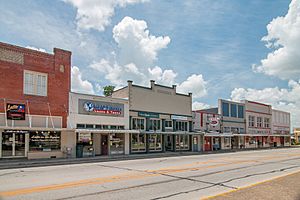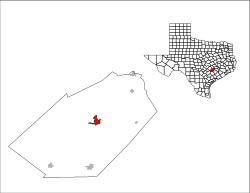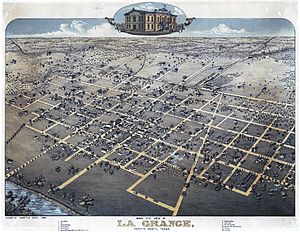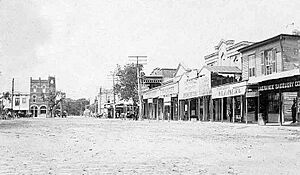La Grange, Texas facts for kids
Quick facts for kids
La Grange, Texas
|
|
|---|---|

Downtown La Grange
|
|

Location of La Grange, Texas. It can be found at the intersection of State Highway 71 and U.S. 77, about an hour's drive east of Austin.
|
|
 |
|
| Country | United States |
| State | Texas |
| County | Fayette |
| Platted | 1837 |
| Incorporated | 1850 |
| Government | |
| • Type | Mayor-Council |
| Area | |
| • Total | 4.15 sq mi (10.74 km2) |
| • Land | 4.14 sq mi (10.71 km2) |
| • Water | 0.01 sq mi (0.03 km2) |
| Elevation | 305 ft (93 m) |
| Population
(2020)
|
|
| • Total | 4,391 |
| • Density | 1,130.80/sq mi (436.62/km2) |
| Time zone | UTC-6 (Central (CST)) |
| • Summer (DST) | UTC-5 (CDT) |
| ZIP code |
78945
|
| Area code(s) | 979 |
| FIPS code | 48-40276 |
| GNIS feature ID | 2411569 |
La Grange (pronounced "lə GRAYNJ") is a city in Fayette County, Texas, United States. It is located near the Colorado River. La Grange is known for being in the middle of the "Texas-German belt."
In 2020, about 4,391 people lived in La Grange. It is the county seat of Fayette County. This means it's the main town where the county government is located.
Contents
Discovering La Grange: A Look at Its Past
La Grange was an important crossing point over the Colorado River. This was along an old road called La Bahía during the time Spain ruled Texas. The first Anglo-American settlers came to this area in the early 1800s.
In 1822, some of Stephen F. Austin's first colonists settled here. A man named John Henry Moore built a blockhouse (a strong fort) in 1828. This was to protect settlers from the Comanche people. This building, called Moore's Fort, was later moved to Round Top for restoration.
By 1831, a small community had grown around Moore's Fort. The town of La Grange was officially planned in 1837. This was during the time Texas was its own country, the Republic of Texas. La Grange became the county seat for the new Fayette County. Both the town and county were named after the Marquis de Lafayette. He was a French hero who helped Americans during the American Revolution. Lafayette's castle in France, the Château de la Grange-Bléneau, inspired the town's name.
Many German immigrants moved to La Grange after 1848. They felt the rolling hills and forests reminded them of their home country. Later, Czech immigrants also settled here. Today, you can still see German and Czech influences in the town's customs and buildings. In the late 1800s, many Jewish immigrants also made La Grange their home. They often arrived through the port of Galveston.
La Grange has several places listed on the National Register of Historic Places. These are important sites recognized for their history. The town was also the starting point for the Mier Expedition. This expedition is famous for the "Black Bean Episode." A historic oak tree, which is still standing, was where the team gathered.
Monument Hill and Kreische Brewery: A Historic Site
After Texas became independent, there were still fights with Mexican forces. In 1842, many Texas militia members were killed near San Antonio. This event is known as the Dawson Massacre. Later, the remains of these soldiers and others from the "black bean death lottery" (Mier Expedition) were buried together. They were reburied in a large tomb in La Grange.
This ceremony happened on September 18, 1848, at a place now called Monument Hill. Over 1,000 people attended, including Sam Houston, a former president of the Republic of Texas.
On January 17, 1849, Heinrich Ludwig Kreische, a German immigrant, bought the land with the tomb. He built a three-story house. In 1860, he started building a brewery. By 1879, it was the third-largest brewery in Texas. Its most famous product was "Kreische's Bluff Beer." Kreische took care of the tomb during his life. However, after he died in 1882, the tomb and brewery began to fall apart. The brewery closed in 1884.
The Kreische family later asked the city to remove the tomb from their property. This was because it was often damaged by vandals. In 1905, the Texas Legislature passed a law to buy the land where the tomb was. The state bought the land in 1907.
During the Great Depression in 1933, the state fenced the area. They agreed to keep it as a state park. This was part of a plan to create jobs and improve public spaces. In the same year, the Daughters of the Republic of Texas bought a new granite vault for the tomb. For the 1936 Texas Centennial, a tall stone monument was built. It has an art deco mural to mark the mass grave.
In 1949, the state gave control of the site to the Texas Parks and Wildlife Department. In 1956, people in Fayette County bought more land around Monument Hill. They gave this land to the state for the park. In 1977, even more land was added, including the Kreische Brewery and Kreische Home. The full site, now called Monument Hill and Kreische Brewery State Historic Sites, opened to the public in 1983. This happened after archaeological studies were finished.
In 1974, a Little League team from La Grange won the Texas state championship.
The Texas Czech Heritage and Cultural Center is located in La Grange. It helps preserve the history and culture of Czech Texans. The center built a new archives building in 2007.
Geography of La Grange: Location and Landscape
La Grange is located slightly northeast of the center of Fayette County. U.S. Route 77 goes through the middle of town. It leads north to Giddings and south to Schulenburg. Texas State Highway 71 passes through the northern part of La Grange. It leads southeast to Columbus and northwest to Smithville.
Austin is about 64 miles northwest via Highway 71. Houston is about 101 miles east via Highway 71 and Interstate 10.
The city covers about 4.15 square miles (10.7 square kilometers). Most of this area is land, with a small amount of water. La Grange sits in the valley of the Colorado River. It is mainly on the northeastern side of the river. The city's lowest point is about 266 feet (81 meters) above sea level.
Climate in La Grange: Weather Patterns
La Grange has hot summers and mild winters. It is known as one of the hottest cities in Texas.
| Climate data for Muldoon, Texas | |||||||||||||
|---|---|---|---|---|---|---|---|---|---|---|---|---|---|
| Month | Jan | Feb | Mar | Apr | May | Jun | Jul | Aug | Sep | Oct | Nov | Dec | Year |
| Record high °F (°C) | 94 (34) |
100 (38) |
104 (40) |
100 (38) |
106 (41) |
107 (42) |
110 (43) |
110 (43) |
110 (43) |
102 (39) |
97 (36) |
92 (33) |
110 (43) |
| Mean daily maximum °F (°C) | 65 (18) |
67 (19) |
73 (23) |
78 (26) |
84 (29) |
92 (33) |
100 (38) |
97 (36) |
91 (33) |
82 (28) |
74 (23) |
62 (17) |
80 (27) |
| Mean daily minimum °F (°C) | 42 (6) |
49 (9) |
52 (11) |
59 (15) |
73 (23) |
80 (27) |
82 (28) |
83 (28) |
75 (24) |
68 (20) |
56 (13) |
44 (7) |
64 (18) |
| Record low °F (°C) | 0 (−18) |
10 (−12) |
15 (−9) |
33 (1) |
42 (6) |
52 (11) |
59 (15) |
60 (16) |
41 (5) |
27 (−3) |
19 (−7) |
0 (−18) |
0 (−18) |
| Average precipitation inches (mm) | 2.75 (70) |
2.37 (60) |
2.51 (64) |
2.92 (74) |
5.95 (151) |
4.46 (113) |
1.3 (33) |
2.42 (61) |
3.8 (97) |
4.22 (107) |
3.10 (79) |
2.60 (66) |
38.59 (980) |
| Source: Weatherbase | |||||||||||||
Demographics: Who Lives in La Grange?
| Historical population | |||
|---|---|---|---|
| Census | Pop. | %± | |
| 1870 | 1,165 | — | |
| 1880 | 1,325 | 13.7% | |
| 1890 | 1,626 | 22.7% | |
| 1900 | 2,392 | 47.1% | |
| 1910 | 1,850 | −22.7% | |
| 1920 | 1,669 | −9.8% | |
| 1930 | 2,354 | 41.0% | |
| 1940 | 2,531 | 7.5% | |
| 1950 | 2,738 | 8.2% | |
| 1960 | 3,623 | 32.3% | |
| 1970 | 3,092 | −14.7% | |
| 1980 | 3,768 | 21.9% | |
| 1990 | 3,951 | 4.9% | |
| 2000 | 4,478 | 13.3% | |
| 2010 | 4,641 | 3.6% | |
| 2020 | 4,391 | −5.4% | |
| U.S. Decennial Census | |||
The table below shows the different groups of people living in La Grange as of 2020. "NH" means "Non-Hispanic."
| Race | Number | Percentage |
|---|---|---|
| White (NH) | 2,487 | 56.64% |
| Black or African American (NH) | 414 | 9.43% |
| Native American or Alaska Native (NH) | 4 | 0.09% |
| Asian (NH) | 17 | 0.39% |
| Pacific Islander (NH) | 4 | 0.09% |
| Some Other Race (NH) | 9 | 0.2% |
| Mixed/Multi-Racial (NH) | 126 | 2.87% |
| Hispanic or Latino | 1,330 | 30.29% |
| Total | 4,391 |
In 2020, there were 4,391 people living in La Grange. There were 1,698 households and 1,043 families.
In 2010, the city had 4,641 people. The population density was about 1,292 people per square mile. About 56.6% of the people were non-Hispanic White. About 8.7% were Black or African American. Hispanic or Latino people made up 35.6% of the population.
Sister Cities: Connecting with the World
La Grange has special connections with two other cities around the world. These are called "sister cities."
 Frenštát pod Radhoštěm, Czech Republic
Frenštát pod Radhoštěm, Czech Republic Olfen, Germany
Olfen, Germany
Education: Schools in La Grange
Students in La Grange attend schools that are part of the La Grange Independent School District.
The schools include:
- La Grange Elementary School
- La Grange Middle School
- La Grange High School
Notable People: Famous Faces from La Grange
Many interesting people have come from La Grange, Texas. Some of them include:
- Homer Bailey: A former professional baseball pitcher.
- J. K. Dobbins: A running back for the Los Angeles Chargers football team.
- Johnnie Johnson: A retired professional football player (cornerback and safety).
- Jeff Kelly: A retired professional football player (linebacker).
- Gabbie Nolen: A country music singer.
See also
 In Spanish: La Grange (Texas) para niños
In Spanish: La Grange (Texas) para niños



